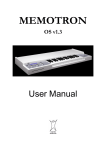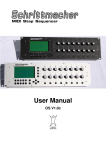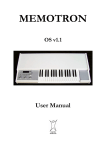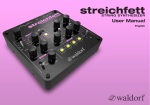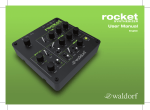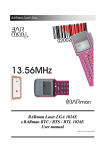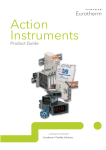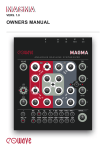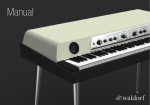Download Manikin Memotron User manual
Transcript
MEMOTRON Rack OS v1.2 User Manual Preface Many thanks for purchasing the Memotron Rack. The Memotron Rack enables you to reproduce the famous sound of the original instrument with highest authenticity. Thanks to latest digital technology, the Memotron Rack is easy to use and most reliable in every stage and studio situation. To become familiar with the Memotron Rack’s capabilities, we recommend you to take a break and study (and internalize...) this manual first. Enjoy your Memotron Rack! Your Manikin team The Memotron Rack development team: Thorsten Feuerherdt : Hardware, Design Markus Horn : Software, Design Mario Schönwälder : Beta testing Klaus Hoffmann-Hoock : Sounds, Beta testing, user manual, sound collection user manuals Version : June 2011 Special thanks to Till Kopper, Stephen Parsick, Christian Peters, Shawn Cleary, Thomas Fanger, Andreas Schneider, Evi Kruckenhauser, Nicole Lehmann and all others we might have forgotten to mention here. Note Manikin Electronic will not assume any responsibility for errors which may occur in this manual. The content of these instructions is subject to change without prior notice. When this manual was created, good care was taken to exclude any mistakes and contradictions. Manikin Electronic will not accept any guarantees for this manual except those provided by commercial law. No part of this user manual is allowed to be reproduced without the expressly written consent of the manufacturer. Manikin Electronic, Lipaer Straße 5, D-12203 Berlin, Germany Table of contents Introduction..........................................................................................................................1 About this manual............................................................................................................................. 1 Symbols used.............................................................................................................................. 1 Marking of parameters................................................................................................................. 1 General safety instructions............................................................................................................... 2 Suitable location.......................................................................................................................... 2 Mains connection......................................................................................................................... 2 Operation..................................................................................................................................... 2 Maintenance................................................................................................................................ 2 Proper use................................................................................................................................... 2 Controls & Connectors........................................................................................................3 Front................................................................................................................................................. 3 Rear................................................................................................................................................. 3 Setting Up.............................................................................................................................4 Unpacking........................................................................................................................................ 4 Installation........................................................................................................................................ 4 Connections..................................................................................................................................... 4 Basic Operation....................................................................................................................5 Power On......................................................................................................................................... 5 Power Off......................................................................................................................................... 5 Realtime Sound-manipulation Functions..........................................................................................5 Menu-driven Functions..................................................................................................................... 6 Track-Menu ..........................................................................................................................8 Load Tracks..................................................................................................................................... 8 Save Tracks..................................................................................................................................... 9 Delete Tracks................................................................................................................................... 9 Initialise Tracks............................................................................................................................... 10 Multi Functions...................................................................................................................11 Loading Multis................................................................................................................................ 11 Saving Multis.................................................................................................................................. 12 Deleting Multis................................................................................................................................ 12 Initialise Multis................................................................................................................................ 13 Storage Device Functions.................................................................................................14 Changing the Memory Card...........................................................................................................14 Sound-Settings...................................................................................................................15 Blending Tracks (Mix)..................................................................................................................... 16 Effect-Setup........................................................................................................................17 MIDI Setup...........................................................................................................................18 Tracks Positioning.......................................................................................................................... 19 Operation-System Update / Info-Page.............................................................................20 Appendix.............................................................................................................................21 Product-Support............................................................................................................................. 21 Technical data................................................................................................................................ 22 Disposal......................................................................................................................................... 22 MIDI Implementation Chart.............................................................................................................24 Glossary......................................................................................................................................... 25 Introduction Even if you are perfectly used to electronic instruments and studio equipment, it will be useful to read this manual entirely. It will help you to get the best out of your Memotron Rack in shortest time. About the Memotron Rack The Memotron Rack is an advanced sample playback based musical instrument to reproduce a famous, specific and genuine sound in highest audio quality. Thanks to its digital technology, it is most reliable and easy to use. Features are: • • • • • • Access to up to six sounds simultaneously Fully polyphony Internal effect processor Complete MIDI-implementation Data storage on Compact-Flash-Card Compatible with G-Media M-Tron® sound library The special characteristics of the original have been carefully emulated. This includes a maximum duration of a played note of about 8 seconds (about 16 seconds at HALF SPEED). The Memotron Rack supports standard data structures of memory cards. This compatibility enables you to create and organise your own Memotron Rack sound library with your PC. The data structure of the Memotron Rack with its directories, folders and files fits to your PC and is easy to understand. The Memotron Rack is compatible with G-Media’s M-Tron® plug-in and can play its sounds (recognizable at the ending .cpt). The Memotron Rack is not compatible with the newer M-Tron Pro® plug-in. About this manual This manual is intended to make the first steps of using the Memotron Rack easier for you. Moreover it also provides support and hints to the experienced user for his/her daily work. Symbols used To ensure a better overview, this manual uses standardized spelling and symbols which are explained below. Important notes are highlighted in bold print. ! Attention – Pay special attention to this note to avoid malfunctions i Gives some short additional information Instructions – Observe these instructions to execute the requested function Marking of parameters All designations of buttons, controllers and parameters of the Memotron Rack in the text are highlighted in bold print. Example: Press the ESC-button The value range permitted for a parameter setting is highlighted by indicating the maximum and minimum values in italics, separated by three dots. Settings, which cannot be represented by a value range, are separated by a comma. Example: Rx Channel 01 ... 16, omni Memotron Rack OS v1.2 User Manual 1 General safety instructions Please read the safety instructions below very carefully. They comprise some basic rules for the use of electronic devices. Please read all the notes before you start using the device. Suitable location • • • • • • Only operate the device in closed rooms. Never operate the device in humid environments such as bathrooms, washing rooms or swimming pools. Do not operate the device in extremely dusty or dirty environments. Ensure unhindered air supply to all sides of the device. Do not place the device in close proximity of heat sources such as radiators. Do not expose the device to direct sunlight. Do not expose the unit to heavy vibration. Mains connection • • • • • Only use the supplied connection cable or the supplied power supply. If the supplied mains connector does not fit into your socket you should consult a qualified electrician. Disconnect the mains connector from the socket if you do not use the device for a longer period of time. Never touch the mains connector with wet hands. When disconnecting, always pull the connector and never the cable. Operation • • • Never place any vessels containing liquids on top of the device. Ensure that the device cannot move during operation. We recommend to install it into a 19“rack or to put it on a sturdy pad. Ensure that no objects can get inside the device. Should this happen against all odds, switch the device off and disconnect it from the mains. Then contact a qualified technician. Maintenance • • Do not open the device. Any repair or maintenance should be done by qualified tech-personnel only. There are no parts inside the device that could be maintained by the user. You will also lose your right to claim warranty if you open the device. Only use a dry, smooth cloth or brush for cleaning the device. Do not use any alcohol, solvents or similar chemicals. They will damage the surfaces. Proper use This device is exclusively intended for creating audio signals and creating and processing control signals according to the MIDI standard. Any other use is not permitted and will exclude any warranty claims towards Manikin Electronic. 2 Memotron Rack OS v1.2 User Manual Controls & Connectors Front POWER: OUTPUT Phones: VOLUME: DATA: ESC: MEMORY CARD: Power switch Headphones-out Master-volume Encoder with click-function to edit menu-driven functions Exits the current menu-page, cancels a function Card slot for insertion of a Compact-Flash-memory-card Rear OUTPUT Left / Right: MIDI In: MIDI Thru: AC In: Stereo audio-out, Line-level, unbalanced. MIDI-Data input Data coming in on MIDI-In jack is transmitted to the MIDI-thru jack. Power supply socket Memotron Rack OS v1.2 User Manual 3 Setting Up Unpacking When unpacking, please check if all parts are included. If something should be incomplete, please contact your local Manikin Dealer immediately. The Memotron Rack box contains: • • • • • the Memotron Rack power cable this manual one memory card (compact flash) one CD-ROM packed with sounds We recommend to keep the original box for further transportation – or better – purchase a suitable rack-case. Installation We recommend installing it into a 19“rack as it only uses one height unit. If there is no suitable option put the device on a clean and even pad. Connections You require a mains outlet and a suitable audio system or at least a headphone. i The Memotron Rack automatically adapts to your local power system (110V – 240V AC) How to hook up the Memotron Rack: 1. Make sure, that both the Memotron Rack and your audio system are powered OFF. 2. Connect the included power cable to the Memotron Rack’s AC socket and to a suitable power outlet. 3. Connect the audio-output of the Memotron Rack to the line-level inputs of your audio system. Use shielded high quality ¼ inch mono jack cables. By connecting only the „LEFT“ socket of the Memotron Rack, it can be hooked up to a mono audio system. 4. Connect the MIDI input of the Memotron Rack with the MIDI output of a master keyboard, a computer or a sequencer (like the Manikin Schrittmacher) using only fitting MIDI cables. 5. Power ON the Memotron Rack and subsequently your audio system (!) 6. Proceed with chapter „Basic Operation“ on the next page. 4 Memotron Rack OS v1.2 User Manual Basic Operation Power On Push the Power switch to switch on the Memotron Rack. The Memotron Rack will need some seconds to initialise and will then be ready for use. ! Attention – First power ON the Memotron Rack and secondly power ON your audio system in order to avoid a cracking noise. Power Off Push the Power switch to switch off Memotron Rack. ! Attention – First power OFF your audio system and secondly power OFF the Memotron Rack in order to avoid a cracking noise. Realtime Sound-manipulation Functions Memotron Rack sounds are called tracks. Up to six tracks can be used simultaneously and sonically processed via MIDI. As each track can be assigned to a separate MIDI channel, all tracks can be separately processed in their sound. • VOLUME (Control Change 7) defines the output volume of a track. • Mix (Modulation / Control Change 1) allows you to blend tracks steplessly, simulating the shifting of the Tron’s tape head block. The six tracks can be freely allocated to the three mix positions (A – lower position, B – middle position and C – upper position). For this function you must activate the parameter „x_Mix“ in the sound-settings for each track and assign each blendable track to the same MIDI channel. • PITCH (Pitchbend) shifts the pitch 3 halftones up and 3 halftones down. This will slightly affect the maximum duration of a played note. • TONE (Control Change 74) changes the sonic character with help of a passive 12 dB lowpass filter. • HALF SPEED (Control Change 12) emulates halving the tape speed. The playback-pitch will be lowered by one octave and the duration of a played note is doubled. HALF SPEED also emulates a slight reduction of the audio quality, especially in higher frequency ranges. If you use a Memotron keyboard, all sound functions of the Memotron Rack can be controlled directly. ! Any real-time sound settings can only be used for your performance and can not be stored permanently. Memotron Rack OS v1.2 User Manual 5 Menu-driven Functions All other functions of the Memotron Rack are controlled via the menu with the help of DISPLAY and DATA-knob. These functions are: • Loading, storing and deleting multis (sound data and effect settings) within the multi menu • Loading, storing and deleting tracks (sound data) within the track menu • Editing the track settings (sound settings) • Editing the effect-section (effect setup) • Editing the MIDI-functions (MIDI setup) • Updating the operation software (info) Basic access to menu-driven functions: 1. Move the DATA-knob to place the CURSOR in the desired position. Menus may cover several display-pages – simply turn the DATA-knob... 2. Click the DATA-knob to select a function or to enter a deeper menu-level. 3. Move and click the DATA-knob to select a parameter and to enable a parameter value change. 4. Move the DATA-knob to alter the value of the selected parameter. 5. Press the ESC-button to cancel a function and / or return to a higher menu-level. 6 Memotron Rack OS v1.2 User Manual The menu overview shows all menu-driven functions of the Memotron Rack. Memotron Rack OS v1.2 User Manual 7 Track-Menu As already mentioned, the Memotron Rack makes use of sample data to produce its sounds. To play them, these sounds have to be loaded into the internal memory of the Memotron Rack. Tracks contain all sound-data (samples) for a specific sound. The track menu provides functions to load tracks from the Compact-Flash-Card. Next to this, tracks can be saved to a memory card or, if desired, be deleted. Suitable Compact-Flash-Cards can be purchased at Manikin Electronic. i The Memotron Rack is compatible with G-Media’s M-Tron® plug-in and can play its sounds (recognizable at the ending .cpt). The Memotron Rack is not compatible with the newer MTron Pro® plug-in. i M-Tron® sound files (file-name .cpt) that are installed on your Windows PC cannot be used in the Memotron Rack. But it is no problem to copy sound files from your G-Media M-Tron® CD-ROMs on your PC, organize them and then use them in the Memotron Rack. Mac users do not have to care about this. They may also copy installed M-Tron® sound files and use them in their Memotron Rack. Load Tracks Up to six tracks simultaneously can be loaded into the Memotron Rack’s internal memory. Please make sure, that the desired Flash-Card has been inserted into the card-slot. Please see chapter “Change Memory Card” on page 14. To select the desired track destination (A, B, C, .. F), click the DATA-knob. You are now prompted to the track menu. Select "Load Track" to enter the file system. Quite similar to an ordinary PC, drives (the Flash-Card) can be selected and directories and files can be accessed. Clicking the DATA-knob while a directory is selected will enter this directory. Clicking the DATA-knob while an .mtk or .cpt file is selected will load the sample data into the previously selected track slot. When clicking ”. .” in the file system view, you are prompted back to the next higher directory-level. Pressing the ESC-button in the file system view cancels the loading process and the display returns to the track menu. Clicking the DATA-knob again will load the selected track into the internal memory (RAM) of the Memotron Rack. When loading is done, the display jumps back to the track settings. Please note, that a previously loaded track will be overwritten without warning. Once a directory-path has been used, you will be automatically re-routed to it at the next loading, saving or deleting process. 8 Memotron Rack OS v1.2 User Manual Save Tracks This function is useful to draw up your sound library independently from a computer. Tracks can be saved onto an inserted memory card. Please note that only sample data, not sound parameter and effect settings, are saved as a track. Sound parameters and effect settings have to be saved within a “multi”. Please refer to section “Save multis” on page 12. Before a track can be saved, it has to be loaded into the Memotron Rack's internal memory. Please refer to section “Load Tracks” on page 8. The track to be saved has to be selected within the sound settings (A, B, C, .. F) and will be saved onto the Flash-Card as soon as the Save-function is executed. When the Save-process is complete, the display jumps back to the track settings. Delete Tracks The ”Delete”-function is used to erase tracks on the inserted Flash-Card. If you just want to delete a track from the Memotron Rack's internal memory, please use the “Initialise Track” function, described on page 10. To delete a sound file from a memory card, please enter the track menu. By selection of “Delete Track”, you are prompted into the current directory. Now you can choose a track on the Flash-Card which will be erased. The Delete-function shows a warning, before the process can be executed. To cancel the function, please select “No” at the warning or press the ESC-button. When deleting is done, the display jumps back to the track settings. ! The finished delete-process can not be made undone – please pay attention! Memotron Rack OS v1.2 User Manual 9 Initialise Tracks This function is used to initialise the selected track. Sample-data and the corresponding track settings will be erased. Effect settings are not affected. Please select the track to initialise from the sound settings (A, B, C, .. F). Enter the track menu and select “Init Track” and the Init-menu opens up. Choose “No” or hit the ESC-button to cancel the function and jump back into the track menu. Choose “Yes” to initialise the selected track. When initialisation is done, the display jumps back to the track settings. ! 10 The finished initialisation process can not be made undone – please pay attention! Memotron Rack OS v1.2 User Manual Multi Functions Multis can be used to access complete setups that are made up of up to six tracks and their corresponding parameter settings. The functions of the multi menu are "load", "save", "delete", and "initialise". In a multi only the track names and their position on the memory card are stored, not the sound data. This helps to store faster and saves the card’s space. Nevertheless the used tracks must be stored on the inserted memory card while you load a multi. ! Please note that tracks in the Memotron Rack’s internal memory will be lost, as soon as the Memotron Rack is powered down and therefore have to be saved on Compact-Flash-Card previously! Loading Multis To load a multi, the desired memory card has to be inserted into the Memotron Rack first. If that has not been performed yet, please change the corresponding storage medium. Refer to section "Change Memory Card" on page 14. Use the DATA-knob to browse through the menu levels until you reach the "Sound Settings" page. Select "M:" and enter the multi menu. Click on "Load Multi" and open the file directory. Choose “Card:” and select the desired multi. To cancel the loading process and leave the directory, simply hit the ESC-button. When pushing the DATA-knob, the selected multi will be loaded with all its settings. In case the selected multi requires a track that is not to be found on the currently inserted memory card, an error message will pop up and the loading process will be aborted. When the loading process has been completed successfully, the display will return to the sound settings page. Memotron Rack OS v1.2 User Manual 11 Saving Multis Use the DATA-knob to browse through the menu levels until you reach the "Sound Settings" page. Select "M:" and enter the multi menu. Selecting "Save Multi" allows you to enter a name for the multi in question. Turn the DATA-knob to select characters and numbers and push the DATA-knob to add them to the multi name. By using [BACKSPACE] you can delete the last character entered. When you are done, use [SAVE] to store the multi. If a multi of the same name already exists on the memory card, a warning message will pop up. You will be asked whether the existing multi is to be replaced with the new one or not. If you hit " No" the process will be aborted, "Yes" will complete it and take you back to the sound settings page. Deleting Multis This function deletes multis from an inserted memory card. If you wish to delete a multi from the Memotron Rack's internal memory (RAM), please refer to the section "Initialising Multis" on page 13. To delete a multi from a memory card, please enter the multi menu. Selecting "Delete Multi" will open the file directory. Browse through the file system and select the desired multi. To quit the deleting process and leave the directory, simply hit the ESC button. When pushing the DATA knob, a warning message will pop up. If you hit "No", the process will be aborted. Hitting "Yes" will complete it and take you back to the sound settings page. ! 12 The finished initialisation process can not be made undone – please pay attention! Memotron Rack OS v1.2 User Manual Initialise Multis This function will initialise a loaded multi from the Memotron Rack’s internal memory (RAM), that means all corresponding track parameters and effect settings will be erased or reset to their default values. After selecting "Init Multi", a warning message will pop up. Select "No" or push the ESC button to cancel the initialisation of the multi and return to the multi menu. Selecting "Yes" will execute the initialisation of the selected multi. As soon as the initialisation process has been completed, you will be taken back to the sound settings page. ! The finished initialisation process can not be made undone – please pay attention! Memotron Rack OS v1.2 User Manual 13 Storage Device Functions To change a memory card, the Memotron Rack’s necessary function can be accessed from the multi menu and the track menu. Changing the Memory Card This function will disconnect an inserted Flash Card from the Memotron Rack’s internal processor and mount a new one. First, enter the sound settings and select the multi (M:) or one of the tracks (A, B, C, .. F). From the multi or track menu respectively, please select "Change Card". You will be asked to insert a card. Please push the DATA knob after having inserted a new memory card, and the new card will be mounted. ! 14 Always use this function if you want to change memory cards !!! Changing these without using this function may cause severe tire damage and data loss !!! Memotron Rack OS v1.2 User Manual Sound-Settings The sound settings contain multi and track names as well as various parameters with which you can tailor each track to your personal needs. The following parameters can be adjusted on each of the six tracks: Volume: 0 ... 127 volume of the track Attack: 0 ... 127 fast or slow attack-phase of the sound Release: 0 ... 127 fast or slow decaying sound after release of key Panorama: L64 ... C00 ... R63 stereo panning (with Left, Center and Right) All sound setting parameters can be accessed by turning the DATA knob. A selected parameter can be edited by pushing the DATA knob. The cursor will turn into a pointer. Turning the DATA knob will now alter the parameter values. Pushing the DATA knob again will confirm the value changes and another parameter can be selected for tailoring by turning the DATA knob. By pressing the ESC button you can leave the sound settings and return to the main menu. Memotron Rack OS v1.2 User Manual 15 Blending Tracks (Mix) Like with the Memotron Keyboard, the Memotron Rack offers the possibility to blend tracks. To control the blending effect you can use the mod-wheel of a master keyboard or the ABC-controller of a Memotron keyboard. While each track of a Memotron keyboard is assigned to a fixed mix position, you can define in which mod-wheel position each track of the Memotron Rack can be heard. In the basic setting the blending function of all tracks is initially deactivated and regardless of the mod-wheel, all tracks can be heard. In the sound settings the parameters „A_Mix“ to „F_Mix“ of the mix-modus define for each track the following adjustments: • • off A: • B: • C: The blending of this track is deactivated. It can be heard constantly. The track can be heard at full volume in the lower position of the mod-wheel respectively the A-position of the ABC-controller. Moving it towards the middle position/ B-position constantly fades out the track. The track can be heard at full volume in the middle position of the mod-wheel respectively the B-position of the ABC-controller. Moving it towards the lower or upper position/ A- or B-position constantly fades out the track. The track can be heard at full volume in the upper position of the mod-wheel respectively the C-position of the ABC-controller. Moving it towards the lower position/ B-position constantly fades out the track. The following illustration shall explain the various blending options. In this configuration the tracks A and B can be heard when the mod-wheel is in the upper position. Track C can be heard in the middle position and the tracks D, E and F when the mod-wheel is in the lower position. Between those settings a mix with corresponding volumes can be heard. 16 Memotron Rack OS v1.2 User Manual Effect-Setup The Memotron Rack features an easy to use Effect-Setup, which clearly increases its sonic capabilities, especially in a live-situation. The Effect-Setup offers 15 different effect-algorithms: 1. 2. 3. 4. 5. 6. 7. 8. 9. 10. 11. 12. 13. 14. 15. Hall 1 Hall 2 Room 1 Room 2 Room 3 Plate 1 Plate 2 Plate 3 Chorus Flanger Delay 1 Delay 2 Chorus / Room 1 Chorus / Room 2 Rotary Speaker The following parameters can be edited: Parameter Range Description Effect Disabled / Enabled Deactivates / Activates the internal effects device Prog Hall1 … Rotary Speaker Selects one of the 15 effect algorithms Send 0% ... 100% Adjusts the amount of effect in the output signal Enter the effect setup from the main menu. A selected effect parameter can be edited by pushing the DATA knob. The cursor will turn into a pointer. Turning the DATA knob will now alter the parameter values. Pushing the DATA knob again will confirm the value changes and another effect parameter can be selected by turning the DATA knob. By pressing the ESC button you can quit the effect settings section and return to the main menu. Memotron Rack OS v1.2 User Manual 17 MIDI Setup The MIDI-Setup controls all functions that are used to play the Memotron Rack from a suitable external MIDI-device (e.g. master-keyboard or a MIDI-sequencer such as the Manikin Schrittmacher). The following parameters can be edited: Parameter Range x_Channel 1 ... 16 Description MIDI channel on which the track receives MIDI data x_Place C_0 … G_10 MIDI place on which the first note is played x_First G_3 … F_6 First played note of a track x_Last G_3 … F_6 Last played note of a track Enter the MIDI-Setup via the main menu. A selected MIDI parameter can be edited by pushing the DATA knob. The cursor will turn into a pointer. Turning the DATA knob will now alter the parameter values. Pushing the DATA knob again will confirm the value changes and another MIDI parameter can be selected by turning the DATA knob. By pressing the ESC button you can quit the MIDI settings and return to the main menu. 18 Memotron Rack OS v1.2 User Manual Tracks Positioning Usually a track comprises 35 sounds that can be played in the range from ”G 3“ to “F 6“. In the Midi settings each track can be positioned by means of the parameter ”Place“ while its tonal range can be restricted by the parameters “First“ and “Last“. With “Place“ you can define the first key on the keyboard where the first sound of a track can be heard, while “First“ defines the lowest and “Last“ the highest audible sound of a track. The following illustration shall explain the various options. In this configuration the parameters of track A are unchanged and comply with the standard setting where all 35 sounds of track A are playable in the range of “G 3“ to “F 6“. Due to limitations of space this track’s range was cut at the right side of the illustration. Track B was limited to 12 playable sounds in the range of “C 4“ to “H 4“. Cutting out 5 notes in the lower range and 18 notes in the upper range, track B can be played on a keyboard between “C 3“ and “H 3“. Like Track B track C was restricted to 12 sounds in the range of ”C 4“ to “H 4“. However its sounds are now an octave higher (in the range from „C 4“ to „H 4“) playable. Due to limitations of space this track’s range was cut at the right side of the illustration, too. Memotron Rack OS v1.2 User Manual 19 Operation-System Update / Info-Page Manikin Electronic permanently improves its products and tries, where ever possible, to implement features based on suggestions and ideas of musicians. To keep the Memotron Rack on its latest technical level, Manikin Electronic will launch operationsystem updates from time to time. These updates can easily be installed from the memory card. The procedure is close to simply loading a track (see chapter ”Load Tracks”, page 8). The update process can be accessed via the Info-row in the main menu. Pressing the DATA-knob enters the Info-page. The currently installed operation-system version number is also displayed in this Info-page. To update the operation system, select "Update". Now the file directory will open up. The following procedure is basically the same as loading a track: Select the directory which holds the operation system file. Select the operation system file (named "Rack_OSXX.mos") and push the DATA knob to initiate the update process. The update process will take about two minutes. When the update process has been completed, the display will return to the main menu again. ! While the update process is running, do NOT power down the Memotron Rack !!! The Memotron Rack is ready for performance, as soon as the update process has been successfully performed. 20 Memotron Rack OS v1.2 User Manual Appendix Product-Support If you would like to ask any questions concerning your Manikin Electronic-Product, there are four ways to contact us: 1. Send us an email. [email protected] 2. Send us a telefax. +49 (0) 30 – 63 49 49 51 3. Send us a letter. Manikin Electronic Lipaer Straße 5 D-12203 Berlin Germany 4. In very urgent cases, please call us. +49 (0) 30 – 63 49 49 50 Memotron Rack OS v1.2 User Manual 21 Technical data Power Supply Nominal voltage Maximum power consumption Connector : : : AC 100V - 240V / 50Hz - 60Hz 12W Standard IEC-Type Connections MIDI Line Out Headphones : : : In and Thru Left, right (1/4” Plug, mono) Output (1/4“ Plug) Dimensions and weight Dimensions (width / height / depth) : Overall weight : 483 mm x 44 mm x 265 mm 19” x 1,75" x 10,5” 2,5 kg 4,2 lbs Disposal This device has been manufactured RoHS-conforming in compliance with the requirements of the European parliament and council and thus is free from lead, mercury, cadmium and chromium. Nevertheless this product is special waste and shall not be disposed in ordinary household waste !!! For disposal, please contact your local dealer or Manikin Electronic Lipaer Straße 5 D-12203 Berlin Germany 22 Memotron Rack OS v1.2 User Manual CE This product has been tested and found to comply with the following Harmonised European Standards: EN 55013: 2003, CENELEC EN 55020: 2003, EN61000-3-2: 2000 and EN 61000-3-3: 1995 + corr. 1998 FCC Information (U.S.A.) 1. IMPORTANT NOTICE: DO NOT MODIFY THIS UNIT! This product, when installed as indicated in the instructions contained in this Manual, meets FCC requirements. Modifications not expressly approved by Manikin Electronic may void your authority, granted by the FCC, to use this product. 2. IMPORTANT: When connecting this product to accessories and/or another product use only high quality shielded cables. Cable/s supplied with this product MUST be used. Follow all installation instructions. Failure to follow instructions could void your FCC authorisation to use this product in the USA. 3. NOTE: This product has been tested and found to comply with the requirements listed in FCC Regulations, Part 15 for Class „B“ digital devices. Compliance with these requirements provides a reasonable level of assurance that your use of this product in residential environment will not result in harmful interference with other electronic devices. This equipment generates/uses radio frequencies and, if not installed and used according to the instructions found in the users manual, may cause interference harmful to the operation of other electronic devices. Compliance with FCC regulations does not guarantee that interference will not occur in all installations. If this product is found to be the source of interference, which can be determinated by turning the unit „OFF“ and „ON“, please try to eliminate the problem by using one of the following measures: Relocate either this product or the device that is being affected by the interference. Utilise power outlets that are on branch (Circuit breaker or fuse) circuits or install AC line filter/s. In the case of radio or TV interference, relocate/reorient the antenna. If the antenna lead-in is 300 ohm ribbon lead, change the lead-in to coaxial type cable. If these corrective measures do not produce satisfactory results, please contact the local retailer authorised to distribute this type of product. The statements above apply ONLY to products distributed in the USA. Canada The digital section of this apparatus does not exceed the „Class B“ limits for radio noise emissions from digital apparatus set out in the radio interference regulation of the Canadian Department of Communications. Le present appareil numerique n’emet pas de briut radioelectri-ques depassant les limites aplicables aux appareils numeriques de la „Classe B“ prescrites dans la reglement sur le brouillage radioelectrique edicte par le Ministre Des Communications du Canada. Ceci ne s’applique qu’aux produits distribués dans Canada. Other Standards (Rest of World) This product complies with the radio frequency interference requirements of the Council Directive 89/336/EC. Cet appareil est conforme aux prescriptions de la directive communautaire 89/336/EC. Dette apparat overholder det gaeldenda EF-direktiv vedrørendareadiostøj. Dieses Gerät entspricht der EG-Richtlinie 89/336/EC. Memotron Rack OS v1.2 User Manual 23 MIDI Implementation Chart Model: Memotron Rack Function ... Basic Channel Mode Note Number Velocity After Touch Pitch Bender Control Change Default Changed Default Messages Altered True Voice Note ON Note OFF Key’s Ch’s 1 7 10 12 74 Prog Change: True System Exclusive System : Song Pos : Song Sel Common : Tune System : Clock Real Time : Commands Aux : Local ON/OFF Mes- : All Notes OFF sages : Active Sense : Reset : All Sound OFF Notes Mode 1: OMNI ON, POLY Mode 3: OMNI OFF, POLY 24 Midi Implementation Chart Transmitted x x x x ********** x ********** x x x x x x x x x o x ********** x x x x x x x x x x x Recognized 1 1 – 16 3 x x 0 – 127 0 – 127 o v=1-127 o x x o 3 semi o o o o o x x x x x x x x x o (123-125) x x o Mode 2: OMNI ON, MONO Mode 4: OMNI OFF, MONO Memotron Rack OS v1.2 User Manual Date: Version: 27.Mai.2010 1.0 Remarks Transpose Modulation Wheel (Mix) Volume Panorama Effect Ctrl (Half Speed) Tone o: Yes x: No Glossary Aftertouch Most modern MIDI keyboards can generate Aftertouch messages. If you press down on a key while it is already playing on such a keyboard, this aftertouch generates MIDI messages. This can be used to add an expressive volume swell to the sound character (e.g. vibrato). CD-ROM Removable ”Read Only Memory” data storage device. Compact Flash Card Removable, read- and writable data storage device. Keeps data permanently. Control Change (Controllers) Using these MIDI messages it becomes possible to change the sound response of the sound generator. This message basically consists of two parts: • the controller number which determines what is influenced. It can range between 0 and 120, • the controller value which determines the intensity of the modification. Examples of the use of controllers are slowly starting vibrato, movement of the sound in panorama position or influence on the filter frequency. Effect-Algorithm A software-based process to generate a certain kind of sound processing. The Memotron Rack offers the following different effect-algorithms: – Hall: Simulation of a big room / environment – Room: Simulation of a small room / environment – Plate: Simulation of a Plate Reverb – Chorus: Type of signal processing. Several slightly detuned copies of a signal are mixed together, to generate a type of ”choir”-like effect. Adds subtile animation and density to a sound. – Flange: Type of signal processing. A slightly time-delayed copy of a signal is mixed with the original. Adds animation to a sound. – Delay: Echo-effect – Rotary Speaker: Type of signal processing, achieved from rotating speakers (Doppler-effect, Leslie-cabinet). Famous especially for organ-sounds. Effect-Section The Memotron Rack’s internal selection of signal processing features. Drive directory List of available storage devices respectively memory-drives. File-System Hierarchic structure of an electronic storage device, e.g. drives, folders, files. Frame In the Memotron keyboard a combination of up to three tracks plus effect- and MIDI-settings. Low pass filter A filter that alters a sound by attenuating its high frequencies. MIDI MIDI is short for ”Musical Instrument Digital Interface“. It was developed in the early eighties to link electronic musical instruments of different types and from different manufacturers. Up to that time Memotron Rack OS v1.2 User Manual 25 there was no standard for linking several sound generators and so MIDI was a considerable improvement. From then on it became possible to link all devices using easy and always identical connection cables. The basic steps are: A transmitter is always connected with one or several receivers. If, for example, a computer is to play a synthesizer the computer is the transmitter and the synthesizer the receiver. For this purpose all MIDI devices (with only a few exceptions) have two or three connections: MIDI IN, MIDI OUT and possibly MIDI THRU. The transmitting device provides the information to the outside world via its MIDI OUT connection. The data are passed on to the MIDI IN connection of the receiver by means of a cable. The MIDI THRU connection has a special meaning. It makes it possible for a transmitter to reach several receivers. It works in such a way that it provides the incoming signal without any changes. Another receiving device is then simply plugged into the MIDI THRU connector. This process creates a chain in which one transmitter and several receivers are connected. It is, of course, a requested feature that the transmitter can control each individual device separately. Therefore it has to be ensured that the individual devices keep to certain rules among each other. MIDI Channel An important part of most messages. A receiving device only reacts to incoming messages if its set receiving channel is identical with the transmitting channel of the message. This makes clear information transfer to a receiver possible. The MIDI channel can be selected within the range from 1 to 16. Beyond this range a device can be switched to Omni. Then it will receive on all 16 channels. MIDI Clock The time interval of the MIDI Clock message defines the tempo of a musical piece. It is used for synchronizing time-dependent processes. Multi In the Memotron Rack a combination of up to six tracks plus effect- and MIDI-settings. Note on / note off This is the most important MIDI message. It determines the tone pitch and the velocity of the tone generated. The time of its arrival is at the same time the starting point of the tone. The pitch is the result of the transmitted note numbers. It is within the range from 0 to 127. The velocity is within the range from 1 to 127. The value 0 for the velocity means ”NoteOff“, i.e. the note is switched off. Panning Designates the panorama position of a sound. Pitch Bend Pitch Bend is a MIDI message. Although the functions of the Pitch Bend message are similar to those of the control change messages, it represents a message type of its own. The reason why is above all that the Pitch Bend message is transmitted with a considerably finer resolution than the ”usual” controller. This takes into account that the human ear is extremely sensitive to pitch changes. Program Change MIDI messages for selecting the sound program. It is possible to select between the program numbers 1 to 128. RAM = ”Random Access Memory” Memory-area of the Memotron Rack, into which tracks and multis to be played will be loaded. When powering down the Memotron Rack, all data stored in the RAM will be lost, therefore permanent saving on Compact-Flash-Card is needed. Sample data A digitally recorded representation of a sound. Sampling The process of encoding an analogue signal into digital form by reading (sampling) its level at short and precisely spaced intervals of time. 26 Memotron Rack OS v1.2 User Manual System Exclusive data System Exclusive data represent the access to the innermost part of a MIDI device. They enable access to data and functions which are not represented by any other MIDI messages. ”Exclusive“ also means that the data indicated here only apply to one single type of device. Each device has its own System Exclusive data. The most frequent applications for this data type are the transmission of complete memory contents as well as the complete device control by means of a computer. Track In the Memotron Rack one of six independent memory areas into which sound-data can be loaded. Track Settings Parameter settings within a track. Memotron Rack OS v1.2 User Manual 27































